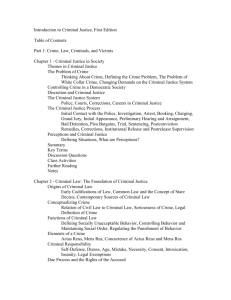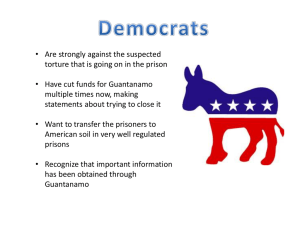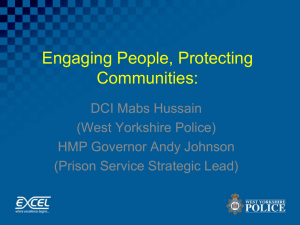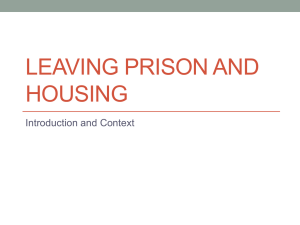Use of Statistics for Policy development
advertisement
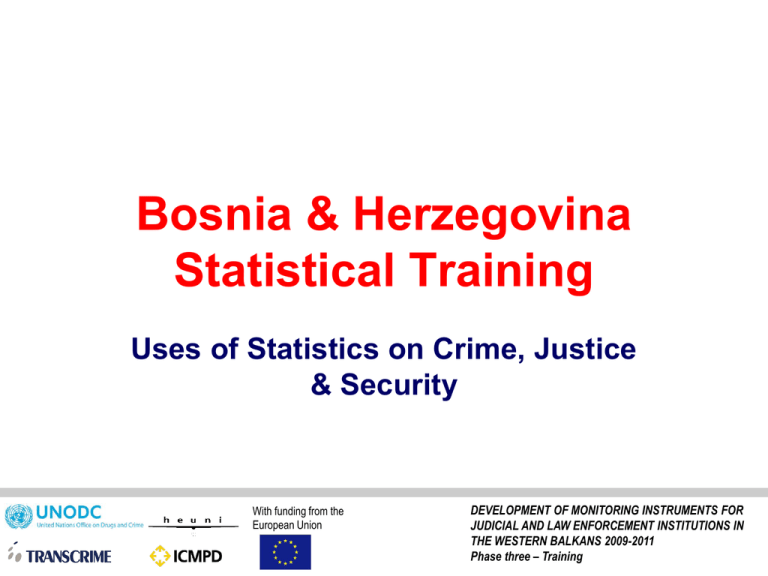
Bosnia & Herzegovina Statistical Training Uses of Statistics on Crime, Justice & Security With funding from the European Union DEVELOPMENT OF MONITORING INSTRUMENTS FOR JUDICIAL AND LAW ENFORCEMENT INSTITUTIONS IN THE WESTERN BALKANS 2009-2011 Phase three – Training Summary Collecting Statistics is expensive. This money will be wasted unless the figures are used properly. There are three main uses of Statistics on crime, justice and security: 1. To enable senior officials to manage each agency effectively 2. To enable agencies to account for their law enforcement to Parliament, the general public and the media. 3. To ensure that policies cutting across more than one agency are properly considered and evaluated A. Statistics to manage agencies effectively The following is needed to manage each agency effectively: 1. Measures of workload and resources, especially personnel 2. Indicators of work carried out by agency 3. Indicators of work not carried out: eg crime not solved: cases delayed. 4. Statistics for each area of the country to show that each area gets its fair share of service. 5. Mechanism for getting figures to managers in a routine fashion 6. Statistical training for managers Workload and Resource Statistics Statistics needed each geographic area Workload Resources Police 1. 2. Crimes recorded, by type Traffic incidents 1. 2. No of police Cost of police Prosecution 1. 2. Cases from police Cases sent to the court 1. 2. No. of prosecutors Cost of prosecutors Courts 1. 2. Cases received Cases disposed of 1. No. magistrates, staff Cost of courts 2. Probation 1. 2. Prisons 1. 2. Probation cases from the courts, by offence Community service orders 1. 2. No. probation officers Cost probation Prisoners in prison, by type Prisoners on remand 1. 2. No. prison officers Cost of prisons Indicators needed by managers For each geographical area Indicator Police 1. 2. 3. Crime recorded per policeman Crime solved per policeman Crimes not solved per policeman Prosecution 1. 2. 3. Cases processed per staff member Cases returned to police per staff member Cases successful in court per staff member Courts 1. 2. 3. Case load per staff member Fines collected by the court Average waiting time in prison Probation 1. 2. Case load per officer Cases successfully completed per officer Prisons 1. 2. Prisoners per police officer Overcrowding of prisons Getting statistics to managers 1. 2. 3. 4. 5. 6. A mechanism is necessary to do this such as a statistical bulletin, briefing note or routine meeting This will need to be at least monthly It should be short and include only a brief selection of figures It also needs a commentary and charts to make the figures easier to read Managers will need to be trained in the use of figures. They also need to feedback their needs for new figures and different ways of presentation. Getting statistics to managers is entirely different from publishing the figures to the Parliament and the public which need not be done so frequently . B. 1. 2. 3. 4. 5. Using Statistics for public accountability The main customers for statistics are the Parliament, the media, the general public and International bodies Members of Parliament should have summary figures presented to them in an annual report. This should be easy to read and include commentary and figures. It should be in the most commonly used language The media need to have summary figures presented to them, probably annually, in easily read form, often at a press conference where questions can be asked. The general public will generally get their figures via the media. However, some people, such as academics, interest groups and students may need special statistics and should be given access to these through special arrangements. International bodies such as the EU and the UN usually ask for data in their own questionnaires Types of statistics required for public accountability Simple summary statistics, in the form of indicators of performance, should be published to show the effectiveness of the justice system: eg 1. Police, Prosecutors, Courts 1. Clear up/complete at least X% of cases reported to them 2. Complete cases within a particular time 3. Maintain public confidence 2. Prisons: 1. reduce overcrowding: 2. improve health: 3. retrain prisoners Setting targets and producing action plans 1. Public accountability often includes setting an action plan for improvement 2. Statistics are an essential part of this 3. Targets can be set for future years based on the indicators of performance set in the previous slide 4. Regular publication would show whether the targets had been met 5. It would also be an essential starting point for discussion on the need for resources in different parts of the justice system. Action plan for using Performance measures 1. Agree in advance which indicators to use 2. Publish this list, together with a base line of current values of the indicators. 3. Measure work load of staff on a regular basis 4. Record measures of success: eg clear-ups: cases finished 5. Record the main time delays for courts. 6. Conduct surveys to obtain public confidence measures in current situation and how the situation is developing. C. Using Statistics for policy development There are several reasons for wanting to change policy: 1. To save money for the government 2. To react to social changes (population change, tourism, drugs, terrorism, organised crime.) 3. To use technical developments more efficiently (fingerprints, DNA, electronic monitoring) 4. Because police, courts, prisons are getting overwhelmed by burden, with resulting inefficiencies. 5. To get more control over the CJ process Who starts off case for change Policy change can be started off by many different areas of the justice system: eg. 1. 2. 3. 4. 5. The finance ministry may seek for savings Politicians and senior officials may wish to pursue legal reform Operational agencies (police, prosecutor, judiciary, probation, prison) may wish to be more efficient Public commentators may exert pressure for change Other countries may seem to be coping better with similar problems However, Statisticians are central to all this as they have access to the figures and can see where things are not as efficient as they might be and can forecast what will happen in the future Examples of possible applications of statistics Many policy areas cut across different justice agencies and use statistics to assist in their planning: five examples of uses are given in the following slides: I. Changing remand policies II. Reducing delays in justice III. Developing sentencing policies IV. Considering legal aid policies Other possible uses of statistics are not covered in the slides a. b. c. Giving police more powers to end cases by giving fixed fines for petty crime. Reducing offending by working with offenders Restructuring the justice system I. Using Statistics to change remand policies • High remand population can lead to wastage of resources: – Costs in feeding prisoners many who do not get a prison sentence – Costs if remand period does not count against sentence • Transport costs in taking cases to court, especially for cases that take a long time to finalize. • Long remand periods when prison service not able to start rehabilitation and prisoners get no chance to work or gain skills • Increased difficulties for lawyers to advise their clients on their legal rights Remand: What is needed • Put together police, courts and prison statistics • Numbers in prison: – by age, gender, offence, region • Length of time spent on remand • Estimates of how many do not get prison sentences: maybe a sample survey needed, • Look at those not remanded to see what problems come about: – skipping bail, delays in cases, new crime committed Remand statistics: possible reactions 1. 2. 3. 4. 5. Accept the current situation and seek for the resources to manage it. Allow time served on remand to count against eventual sentence. Allow period before trial to be spent in the community, perhaps under probation supervision or electronic monitoring. Allow those remanded in prison to start training and rehabilitative work Introduce a maximum time before trial to encourage agencies to become more efficient in their work in preparing the evidence for trial II. Using Statistics to reduce delays • What impact do delays in the court process have and how can these impacts or delays be reduced? • Is delay a problem with the Court process or resources? • Are other factors involved? • Can other players in the criminal justice system assist in reducing delay? Delay: What statistics are needed • Measure the time from arrest to sentence • Break this down between different stages in the process • Identify the causes of delay and those who might address them • Establish agreed actions between the courts and others Delay: Actions that might result • Elements of the court process could be improved, such as setting court dates more quickly and re-organising the availability of court/judicial resources • Other agencies called upon to help – such as police ensuring defendants turn up at court • Arrangements for producing the prisoner from jail to the court could be improved • New arrangements introduced – support or protection for witnesses III. Using Statistics to develop sentencing policies • Are sentences effective. – What is reconviction rate? What do victims think – What does the public think? • Money can be saved by reducing sentences. (Statistics can estimate this.) • Increased sentences would cost more money ( Again can be estimated) • Sentences could be more similar to those in other countries. • Sentencing guidelines could be issued for magistrates and judges. This would give more control. This occurs frequently in the USA. Sentencing: what is needed • Measure of reconvictions: data base needed • Measures of confidence from surveys • Effect of changes in sentencing: apply new rules to last year’s statistics • Examine guidelines from other countries to see whether these could be fitted into your legislation Example looking at sentencing policy • The UK is concerned with sentences for knife crime. Data is on the web site and the trends in prison numbers is: http://www.justice.gov.uk/publications/docs/knife-possessionsentencing-bulletin-jan-march-10.pdf IV. Using Statistics to consider legal aid policies • In many countries the government pays some defence costs: ‘Legal Aid’ • In some countries (EW) LA expenditure is too high. • If more offenders aided legally, perhaps through donor money to start with, then this could pay for itself by reducing the costs of the CJS. • Legal aid could be on arrest as in some countries (eg England & Wales): for court appearance: or for appeal • Some countries have compensation for injury as a result of crime Legal Aid: What is needed • Examine other countries’ rules for legal aid and see how they could be modified for your country • Look at numbers who currently use defence lawyers • Consult lawyers, court staff, offenders, perhaps using a sample survey • Work out impact of changes: length of trials, different guilty rates: different sentences, etc. Conclusions • Statistics can assist in managing criminal justice policies • For each proposed policy change a different set of statistics would need to be calculated • This would need to be supplemented by surveys of opinion. • A base line set of statistics on the current position would be needed • Estimates of potential change can then be made • Researchers can suggest changes that would be possible from their study of work in other countries. Bosnia & Herzegovina Statistical Training Uses of Statistics on Crime, Justice & Security With funding from the European Union DEVELOPMENT OF MONITORING INSTRUMENTS FOR JUDICIAL AND LAW ENFORCEMENT INSTITUTIONS IN THE WESTERN BALKANS 2009-2011 Phase three – Training






